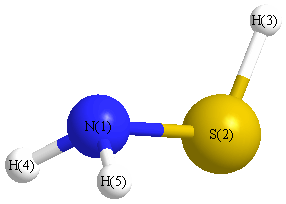Jump to
S1C2
Energy calculated at CCSD(T)/6-31G*
| | hartrees |
|---|
| Energy at 0K | -453.995702 |
| Energy at 298.15K | -453.999472 |
| HF Energy | -453.672960 |
| Nuclear repulsion energy | 57.087589 |
The energy at 298.15K was derived from the energy at 0K
and an integrated heat capacity that used the calculated vibrational frequencies.
Vibrational Frequencies calculated at CCSD(T)/6-31G*
| Mode Number |
Symmetry |
Frequency
(cm-1) |
Scaled Frequency
(cm-1) |
IR Intensities
(km mol-1) |
Raman Act
(Å4/u) |
Dep P |
Dep U |
|---|
| 1 |
A' |
3487 |
3355 |
|
|
|
|
| 2 |
A' |
2676 |
2575 |
|
|
|
|
| 3 |
A' |
1695 |
1631 |
|
|
|
|
| 4 |
A' |
1054 |
1014 |
|
|
|
|
| 5 |
A' |
947 |
912 |
|
|
|
|
| 6 |
A' |
676 |
651 |
|
|
|
|
| 7 |
A" |
3587 |
3451 |
|
|
|
|
| 8 |
A" |
1178 |
1134 |
|
|
|
|
| 9 |
A" |
430 |
413 |
|
|
|
|
Unscaled Zero Point Vibrational Energy (zpe) 7865.4 cm
-1
Scaled (by 0.9621) Zero Point Vibrational Energy (zpe) 7567.3 cm
-1
See section
III.C.1 List or set vibrational scaling factors
to change the scale factors used here.
See section
III.C.2
Calculate a vibrational scaling factor for a given set of molecules
to determine the least squares best scaling factor.
Geometric Data calculated at CCSD(T)/6-31G*
Point Group is Cs
Cartesians (Å)
| Atom |
x (Å) |
y (Å) |
z (Å) |
|---|
| N1 |
0.013 |
1.124 |
0.000 |
| S2 |
0.013 |
-0.625 |
0.000 |
| H3 |
-1.328 |
-0.776 |
0.000 |
| H4 |
0.516 |
1.451 |
0.825 |
| H5 |
0.516 |
1.451 |
-0.825 |
Atom - Atom Distances (Å)
| |
N1 |
S2 |
H3 |
H4 |
H5 |
| N1 | | 1.7488 | 2.3255 | 1.0201 | 1.0201 |
S2 | 1.7488 | | 1.3495 | 2.2898 | 2.2898 | H3 | 2.3255 | 1.3495 | | 3.0069 | 3.0069 | H4 | 1.0201 | 2.2898 | 3.0069 | | 1.6497 | H5 | 1.0201 | 2.2898 | 3.0069 | 1.6497 | |
 More geometry information
More geometry information
Calculated Bond Angles
| atom1 |
atom2 |
atom3 |
angle |
|
atom1 |
atom2 |
atom3 |
angle |
| N1 |
S2 |
H3 |
96.430 |
|
S2 |
N1 |
H4 |
108.701 |
| S2 |
N1 |
H5 |
108.701 |
|
H4 |
N1 |
H5 |
107.918 |
Electronic energy levels
Charges, Dipole, Quadrupole and Polarizability
Jump to
S1C1
Energy calculated at CCSD(T)/6-31G*
| | hartrees |
|---|
| Energy at 0K | -453.993967 |
| Energy at 298.15K | -453.997806 |
| HF Energy | -453.672329 |
| Nuclear repulsion energy | 57.408713 |
The energy at 298.15K was derived from the energy at 0K
and an integrated heat capacity that used the calculated vibrational frequencies.
Vibrational Frequencies calculated at CCSD(T)/6-31G*
| Mode Number |
Symmetry |
Frequency
(cm-1) |
Scaled Frequency
(cm-1) |
IR Intensities
(km mol-1) |
Raman Act
(Å4/u) |
Dep P |
Dep U |
|---|
| 1 |
A' |
3497 |
3364 |
|
|
|
|
| 2 |
A' |
2566 |
2469 |
|
|
|
|
| 3 |
A' |
1680 |
1617 |
|
|
|
|
| 4 |
A' |
1048 |
1008 |
|
|
|
|
| 5 |
A' |
905 |
871 |
|
|
|
|
| 6 |
A' |
664 |
638 |
|
|
|
|
| 7 |
A" |
3605 |
3468 |
|
|
|
|
| 8 |
A" |
1163 |
1119 |
|
|
|
|
| 9 |
A" |
540 |
519 |
|
|
|
|
Unscaled Zero Point Vibrational Energy (zpe) 7833.9 cm
-1
Scaled (by 0.9621) Zero Point Vibrational Energy (zpe) 7537.0 cm
-1
See section
III.C.1 List or set vibrational scaling factors
to change the scale factors used here.
See section
III.C.2
Calculate a vibrational scaling factor for a given set of molecules
to determine the least squares best scaling factor.
Geometric Data calculated at CCSD(T)/6-31G*
Point Group is Cs
Electronic energy levels
Charges, Dipole, Quadrupole and Polarizability
